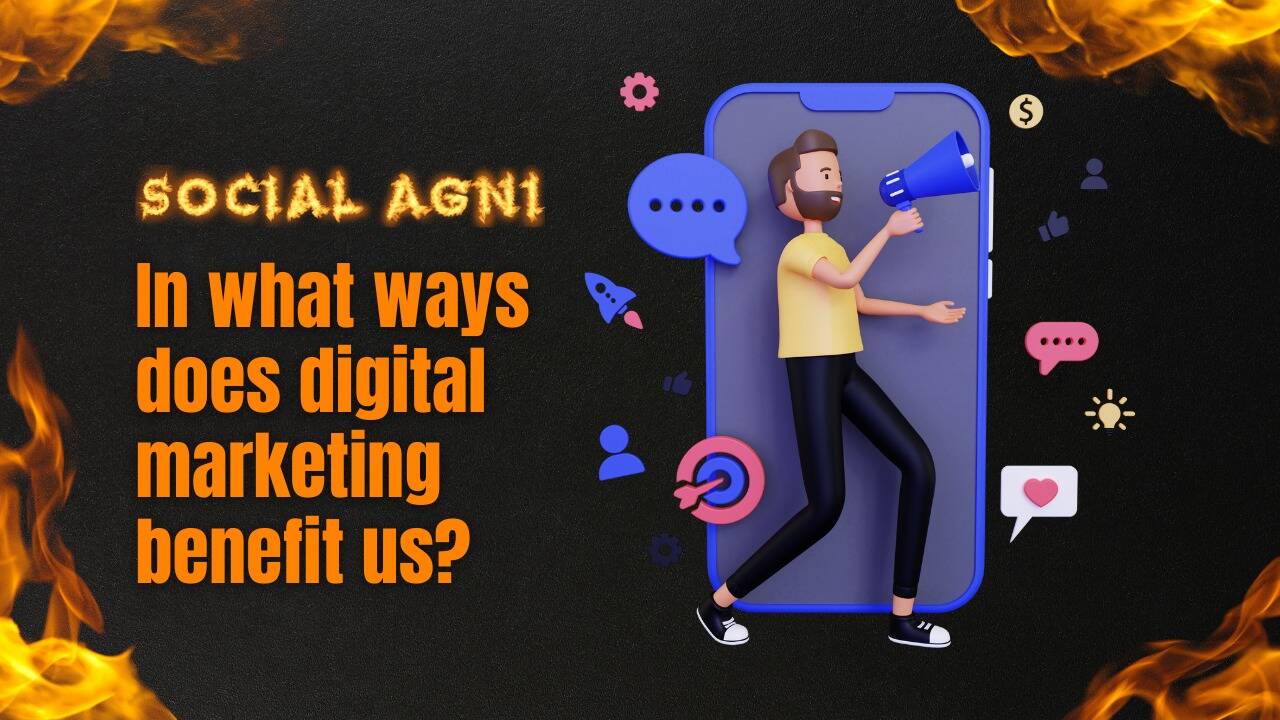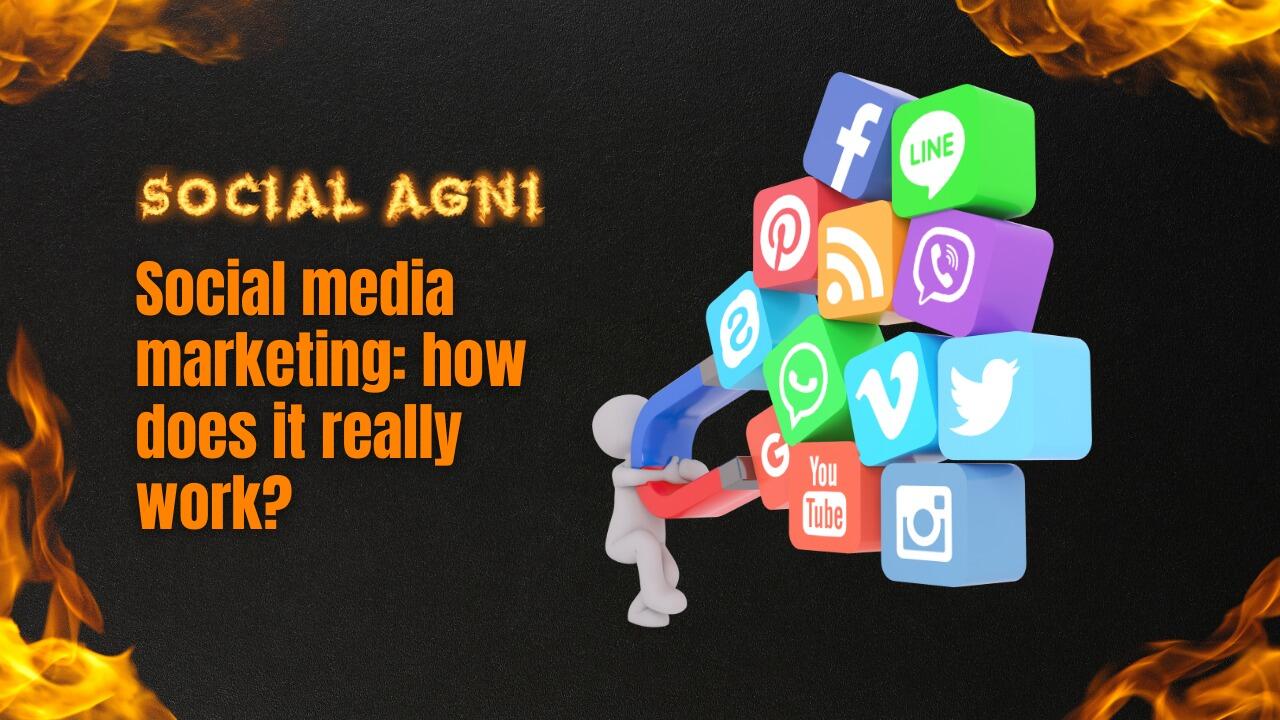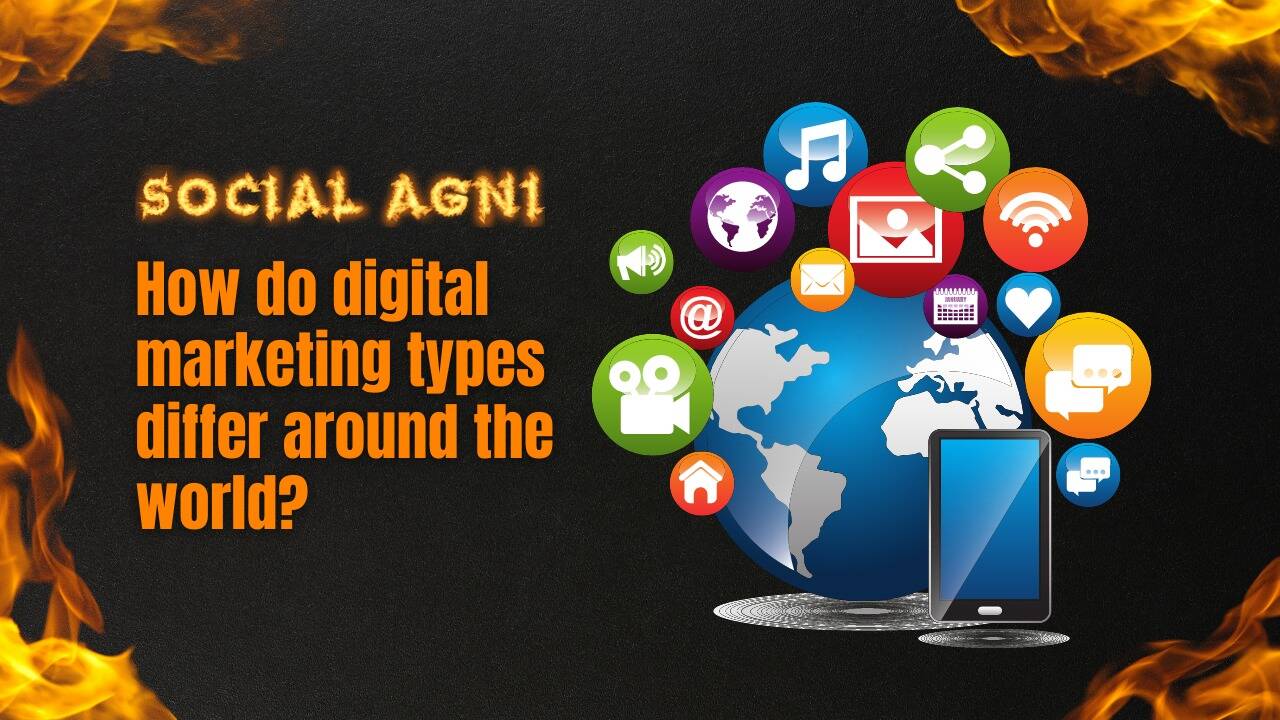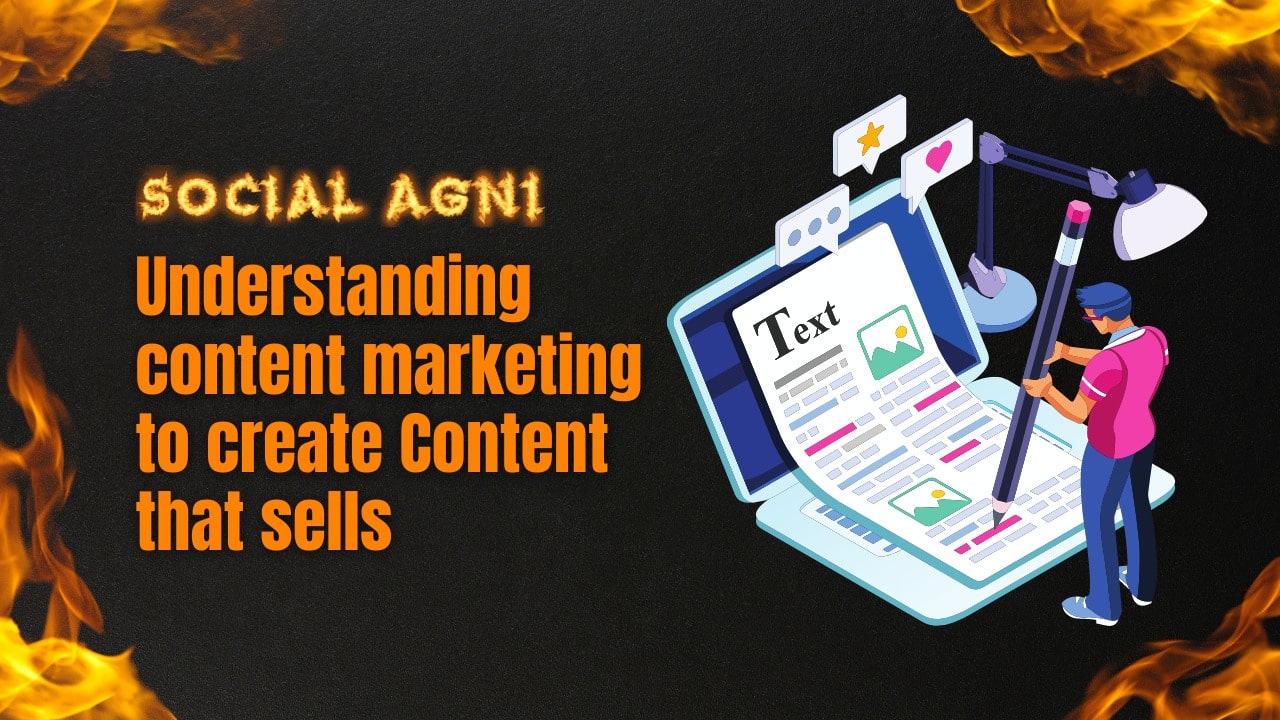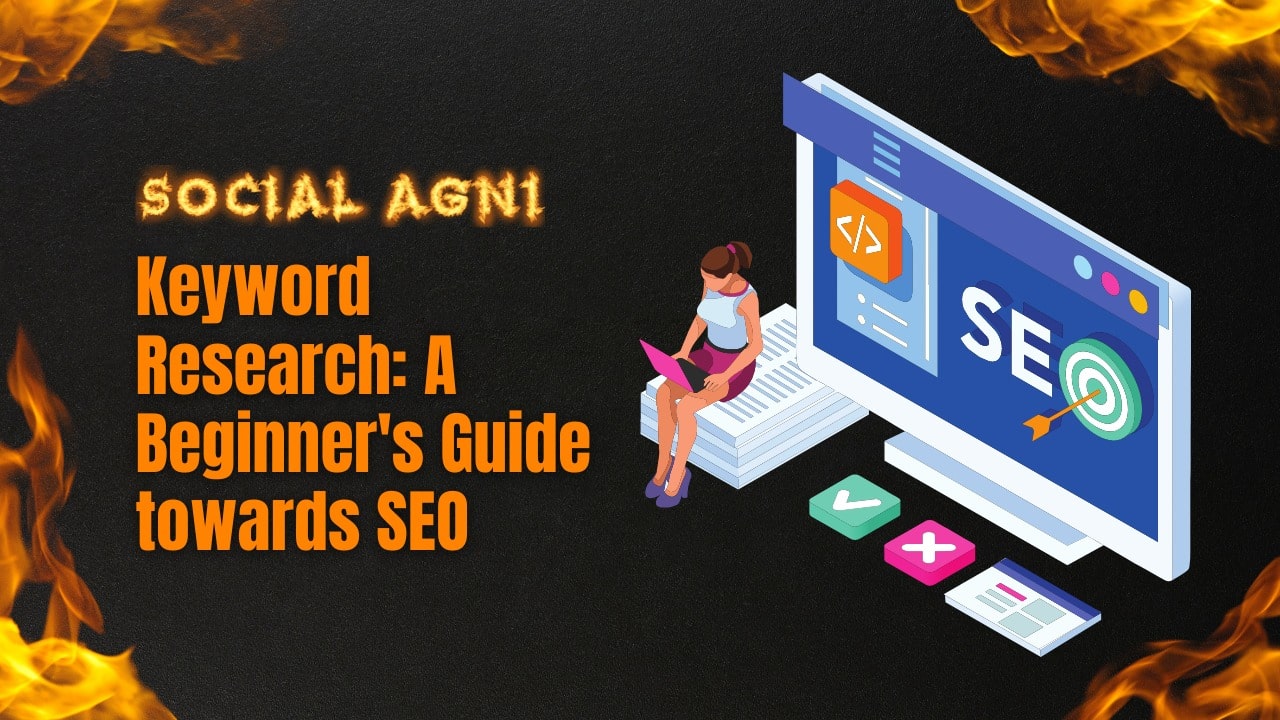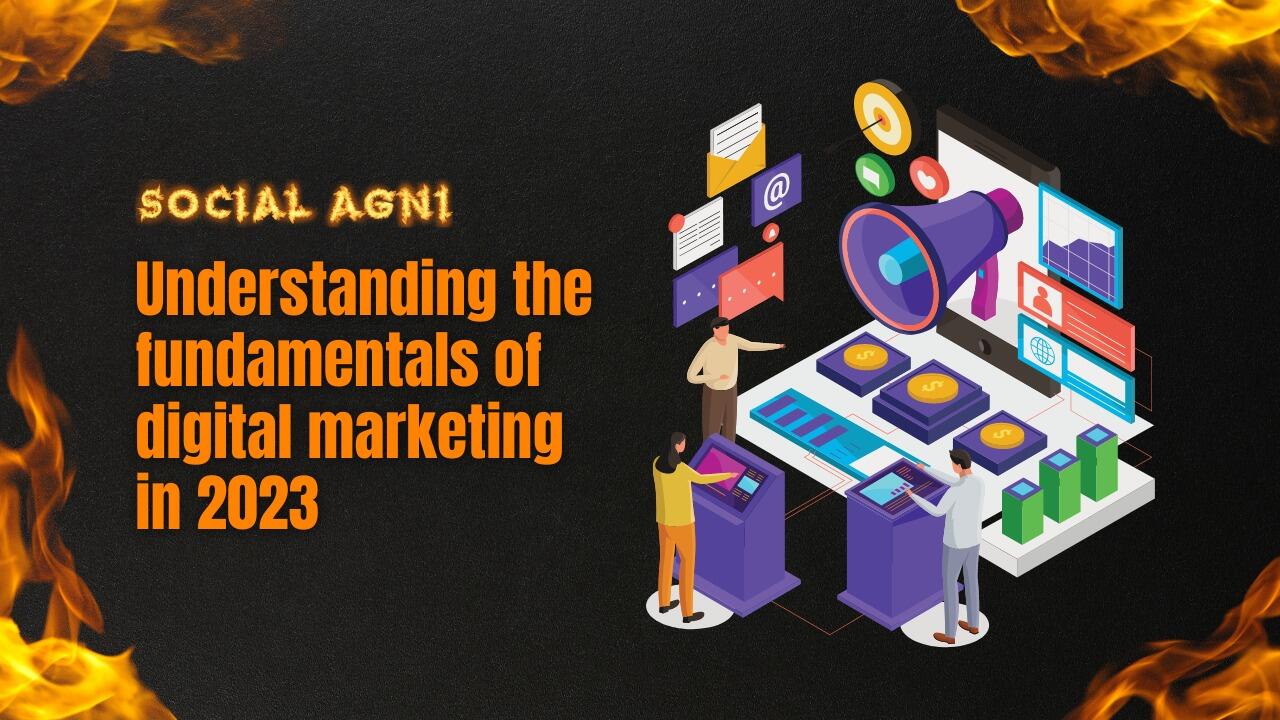Marketing is one of the most important aspects of running a business. It’s the process of creating and delivering messages that promote a product or service to consumers. And while there are many different marketing strategies, digital marketing is one of the most effective. In this article, we’re going to take a look at some of the ways digital marketing benefits us as business owners. What is Digital Marketing? Digital marketing is the process of creating, delivering, and managing content that engages customers and helps businesses achieve their objectives. It encompasses a wide range of activities, including the development and management of websites, search engine optimization (SEO), email marketing, social media marketing, and public relations. It is the use of digital technologies to create, deliver, and measure the results of marketing communications. Digital Marketing is the process of creating, managing and executing a marketing plan that uses electronic media such as email, websites, social media platforms and search engines. It is an essential part of modern business and has a number of benefits for businesses. Digital marketing can help businesses reach a wider audience with more relevant content. By using digital channels such as email and website, businesses can communicate with their customers on a personal level. This allows businesses to build trust and relationships with their customers, which can lead to increased sales. Additionally, digital marketing allows businesses to track the effectiveness of their campaigns through analytics tools such as Google Analytics. This information can help businesses make necessary changes to their marketing strategy if necessary. How Does Digital Marketing Benefit Us? Digital marketing is the practice of using digital technologies, such as the internet, to deliver marketing communications and reach out to customers. It has many benefits for businesses, including increased customer loyalty, brand awareness, and web traffic. Digital marketing can also help businesses track and measure their marketing activities and identify where they need to improve. Digital marketing can offer a number of advantages for businesses, both large and small. Some of the benefits of digital marketing include the following: Increased Reach and Audience Engagement: With digital marketing, businesses can reach a much wider audience than they could with traditional marketing methods. This means that your business can engage with a larger number of potential customers, increasing your chances of achieving success. Greater Efficiency and Improved Customer Retention rates: Digital marketing techniques allow businesses to target their ads more effectively, which means that you’re likely to reach more people with your message and keep them engaged longer. This leads to higher customer retention rates and increased revenue. Reduced Costs: Digital marketing is often more affordable than traditional marketing methods, which means that you can reach a wider range of customers without spending a lot of money. In addition, digital platforms make it easy to track the effectiveness of your campaigns so you can fine-tune them as needed. Increased Brand Loyalty: By engaging customers through digital channels, you can create a bond between your business and its consumers that’s hard to break. This makes it easier for customers to refer your company and promote your products to their friends, increasing your brand’s reach and popularity. Greater Flexibility: Digital marketing platforms are highly flexible, meaning that you can tailor them to the specific needs of your business. This allows you to create custom campaigns that are designed to reach your target audience in the most effective way possible. Increased Customer Engagement: Digital marketing can help you to engagement your customers in ways that’s hard to achieve with traditional marketing methods. For example, you can use digital platforms to create customer surveys and ask them questions about their experience with your product or service. This helps you to improve your customer service and increase loyalty towards your business. Increased Conversion Rates: Digital marketing techniques are often effective at converting leads into customers. This means that you can generate more revenue from your efforts by driving more people to your website or landing page. Increased Brand Awareness: Digital marketing can help to increase brand awareness, which can lead to increased sales and market share. Improved Website Traffic and Conversion Rates: By driving more people to your website, digital marketing can help to improve your web traffic and conversion rates. This means that you’re more likely to reach your target audience and generate leads that can be converted into customers. Increased Social Media Presence: Digital marketing platforms can help you to build a strong social media presence for your business. This can help you to connect with your target audience and promote your products and services to a wider audience. Increased Engagement with Customers: Digital marketing platforms can help you to engage with your customers in ways that’s hard to achieve with traditional marketing methods. For example, you can use digital platforms to create customer surveys and ask them questions about their experience with your product or service. This helps you to improve your customer service and increase loyalty towards your business. Increased Customer Loyalty: By engaging customers through digital channels, you can create a bond between your business and its consumers that’s hard to break. This makes it easier for customers to refer your company and promote your products to their friends, increasing your brand’s reach and popularity. Increased ROI: Digital marketing can often be more effective than traditional marketing methods at generating ROI. This means that you’re likely to achieve a higher return on your investment than you would with other methods. It helps to reach a large audience. Digital marketing can help businesses to reach a large audience through online platforms such as YouTube, Facebook, and Instagram. This allows them to connect with potential customers who may not have heard of them before. It increases sales. Digital marketing can help to increase sales by showing customers how purchasing products or services through digital channels can be more affordable than through other methods. This can encourage customers to make purchases from the business. It builds brand awareness. Digital marketing
Social media marketing has become one of the most popular ways to reach out to potential customers, and for good reason. It’s not just a great way to connect with people who are interested in your product or service, but it can also help you build relationships with potential customers. In this article, we’re going to explore how SMM works and what you need to do to get started. Social media marketing is a terrific way to connect with potential customers and promote your business or product. But just how does it work? In this article, we’ll outline the basics of social media marketing and show you how to put it into practice for your own website or blog. What is Social Media Marketing? Social media marketing is the use of social media platforms like Facebook, Twitter, and Google+, Instagram, LinkedIn, as well as email marketing. There are a number of different strategies that can be used, depending on the platform and the target audience. These platforms are used to promote a business or product, to create and share content with the aim of building relationships and driving sales. It can be used for a variety of purposes, including generating leads and increasing brand awareness It can be used to connect with customers and build relationships, create awareness for a product or service, and drive traffic to a website. SMM can also be used to generate leads and sales. The Different Types of Social Media Marketing Social media marketing can be broken down into three different types: organic, paid, and viral. Organic social media marketing is when a company uses social media to reach out to its target audience without paying for advertising. Paid social media marketing involves a company spending money on ads to promote their product or service. Paid SMM is often more effective at reaching a wider audience than organic social media marketing, but it can also be more expensive. Viral social media marketing refers to using social media platforms to spread the word about a product or service to a wider audience. Viral SMM can have a much larger impact than either paid or organic SMM, but it can also be more difficult to control. Each type of social media marketing has its own benefits and drawbacks. How Does SMM Work? There is no single answer to this question, as the effectiveness of social media marketing depends on a variety of factors, including the type of social media platform being used, the target audience being targeted, and the specific goals being pursued. However, in general, social media marketing involves using online platforms like Facebook, Twitter, and LinkedIn to reach potential customers and followers. For businesses that are already active on social media platforms, these platforms can be used to build relationships with customers and followers. These relationships can then be leveraged to promote products and services, generate leads and sales opportunities, and build brand awareness. However, not all businesses should start their own social media accounts. In fact, many small businesses don’t have the resources or knowledge necessary to create successful social media campaigns. Instead, these businesses can partner with an experienced marketing agency that can help create effective social media strategies tailored to the needs of the business. Whatever approach is chosen, it is important to remember that social media marketing is a dynamic process that must be constantly adapted to meet the changing needs of the target audience. Here’s how SMM works: When people use social media, they are sharing content. This content can be about your business or product. When someone shares your content, they are advertising for you. If a lot of people share your content, it can help you get more attention and make more sales. One way to get more people to share your content is to create great content. This means writing about topics that interest your audience. You can also try out different formatting techniques to make your content look interesting. For example, you could use images or videos to spice up your text. If you want to increase the chances that people will share your content, you need to offer them something in return. You can do this by giving them free products or services, or by giving them exclusive access to information about your business or product. SMM is a powerful way to connect with potential and current customers. When done correctly, it can help your business grow and prosper. However, social media marketing is not easy. It takes effort to create great content, design effective campaigns, and ensure that your followers are given value in return for their time and attention. If you’re interested in starting or improving your SMM efforts, consider hiring a professional marketing agency. They have the experience and resources necessary to help your business reach its full potential on social media. Elements of a Successful Social Media Marketing Strategy There are a few essential elements to a successful social media marketing strategy. Here are four of the most important: Planning – Before starting any SMM, it’s important to have a plan. Figure out what you want to achieve with your campaign and create a timeline for how you’ll get there. This will help ensure that your efforts are coordinated and purposeful. Targeting – Once you have a plan, it’s important to target your audience. Use the data you collected in planning to develop targeted content and social media posts that directly appeal to your followers. Execution – Finally, make sure that you actually execute your strategy. Keep track of what content is performing well and use that information to keep creating new material. Also be sure to monitor your analytics (see below) to see how your audience is responding. Monitoring and Reactions – Finally, be sure to regularly monitor your social media channels and take note of any reactions or responses from your followers. This will help you adjust your strategy as needed and keep track of any trends or
It’s no secret that digital marketing is on the rise, and with good reason. Digital marketing can help you connect with your target audience in a way that traditional advertising simply can’t. However, there are certain types of digital marketing that are more popular in different parts of the world. In this article, we’ll take a look at the different digital marketing types and see how they differ around the world. Digital marketing in different countries Digital marketing in different countries is quite different. eMarketer conducted a study in 2016 that looked at how global digital marketing is changing and how it’s influencing the way businesses operate. The report found that global digital marketing is now dominated by programmatic advertising, which accounts for over 60% of all digital ad spending. Additionally, global social media spending continues to grow, with 52% of companies reporting increased spending on social media in 2016. In contrast, online advertising in Japan is dominated by banner ads that are typically around 150 pixels wide and 240 pixels high. These ads are usually placed on third-party websites or blogs and are often seen as intrusive because they take up a lot of space. In China, online advertising is mostly done through search engine optimization (SEO) techniques that focus on creating quality content so that website visitors will click through to relevant ads. By comparison, Spain focuses on display advertising, which is typically large rectangle or square ads that are displayed on the top or bottom of webpages. Finally, India relies heavily on email marketing to promote products and services to customers. Global digital marketing is changing rapidly, with programmatic advertising becoming the dominant form of digital advertising. Social media spending continues to grow, while online advertising in Japan remains dominated by banner ads. In China, SEO techniques are used to drive traffic to advertiser websites, while in Spain and India email marketing is dominant. Overall, the report found that global digital marketing is moving away from traditional advertising formats and focusing on more effective ways to reach customers. Different Digital Marketing Types There is no single answer to this question as digital marketing methods vary vastly around the world. However, some generalizations can be made about the different types of digital marketing practices used in different countries. a) One of the most common forms of digital marketing is called ‘paid search’. In this method, companies pay websites or search engines to display their ads on a relevant page. Paid search ads are often targeted towards people who have already expressed an interest in the product or service being offered. b) Another popular form of digital marketing is called ‘earned media’. This involves creating content that is highly engaging and shareable and then distributing it through channels such as social media, blogs, and email campaigns. The goal of earned media is to generate awareness and interest in a product or service before actually selling it. c) Another type of digital marketing is called ‘content marketing’. In content marketing, firms create valuable, informative content that they then share across their various channels (such as blog posts, social media posts, and email newsletters). The goal of content marketing is to create a relationship with their customers by providing valuable information and insights. While these are generalizations, they provide a snapshot of some of the most common types of digital marketing practiced around the world. Digital marketing around the world Digital marketing is an umbrella term that refers to all forms of marketing communication and activities that use digital technologies. The main types of digital marketing are online advertising, online customer service, online lead generation, online content marketing, and e-commerce. Online advertising: Online advertising is the most common form of digital marketing. It involves placing ads on websites or blogs. Online advertisers can choose from a variety of ad formats, including text ads, banner ads, and video ads. Online customer service: Online customer service is another type of digital marketing that uses technology to provide customers with solutions to their problems. Customers can contact customer service through email, phone, or live chat. Online lead generation: Online lead generation is a way to generate leads from potential customers who are interested in your product or service. You can generate leads by using online channels such as blogs, social media platforms, and email campaigns. Online content marketing: Online content marketing is a type of digital marketing that uses content to build relationships with customers and promote your products or services. You can create content for your website, blog, social media profiles, and email campaigns. E-commerce: E-commerce is a type of digital marketing that uses electronic systems to purchase goods and services. You can use e-commerce to sell your products and services online. Digital marketing is the use of digital technologies to create, manage, and deliver a message about a product or service. Digital marketing can be classified into three main categories: Online marketing Mobile marketing, and Social media marketing. Each category has its own specific set of strategies and tactics that are used to reach and engage customers. Online marketing includes web advertising, web search engine optimization (SEO), e-mail marketing, and pay-per-click (PPC) advertising. Web advertising is the most common type of online marketing and is used to generate traffic to a website. Web search engine optimization is a technique used to improve the ranking of a website in search engine results pages (SERPs). E-mail marketing is a form of online marketing that uses email messages to communicate with customers. Pay-per-click advertising is an online advertising method that allows companies to place ads on websites with a commission when a user clicks on the ad. Mobile marketing includes using mobile devices to access the internet. Mobile devices are often used to access online content, shop for products, and sign up for services. Social media marketing includes using social media platforms like Facebook, Twitter, LinkedIn, and Google+ to communicate with customers. Social media platforms are often used to share information about a product
Copywriters are responsible for creating content that is both on-message and persuasive for their target audience. They must be able to understand the needs of their customer base, as well as the competition, and write content that will resonate with them. In addition to copywriting, copy editors are also essential in the process of creating effective marketing content – they make sure all the grammar and spelling is correct, as well as making sure the overall tone of the piece is profitable and persuasive. Although copywriters may have a more hands-on role in the creation of marketing content, it is important to note that all members of a team are necessary for a successful project – whether it be in the office or out there in the world. What is Copywriting? Copywriting is the process of creating effective sales copy for marketing materials. It is a skill that requires the ability to understand and communicate a brand’s message to customers. Copywriters must also be able to work with a variety of media, from print ads to social media posts. Copywriting is the process of creating effective and persuasive written communication. It encompasses a wide range of activities from developing story arcs, to crafting headlines, to creating persuasive emails and other online content. Its responsibilities include creating a compelling message that persuades readers to take action, whether that means buying a product, signing up for a service, or voting in an election. Copywriting is a vital part of any marketing campaign, and it has a number of important responsibilities. It is the art of writing effective, persuasive text that can help your brand or product stand out in the competitive market. How Copywriting benefits businesses Copywriting is the process of creating effective, persuasive text for advertising and other marketing communications. It encompasses the art of thinking out loud and putting words together in a way that captures an audience’s attention. Inherent in copywriting is the need to be strategic, as well as creative; effective copy must be both original and relatable. It is an essential part of any company’s marketing strategy. It can help promote a company’s products and services, attract new customers, and build brand awareness. In short, copywriting helps a business achieve its marketing objectives. Copywriting can take many different forms, from corporate website content to brochures and ads. The goal of all copy is the same: to persuade readers to take action, buy a product or sign up for a service. Copywriting is essential for any business that wants to reach a wide audience. Here are four ways copywriting can benefit businesses: Copywriters can help businesses create content that is both engaging and informative. People are drawn to content that they feel they can understand and connect with the better-written content, the more likely people are to read it. Copywriters can help businesses achieve this by using clear language, interesting stories and examples, and compelling images. Copywriting helps businesses clarify their message and focus their efforts on key areas. When done correctly, copywriting can identify customers’ needs and desires and paint a clear picture of what the business can offer. This helps businesses stand out from their competition and attract new customers. Copywriting can help businesses create memorable and effective advertising campaigns. The right copy can capture an audience’s attention and motivate them to take action, whether that’s clicking on an ad or buying a product. Copywriters can help businesses improve the quality of their overall marketing communications. Poorly written copy can frustrate customers and deter them from taking actions like signing up for a newsletter or visiting a website. Copywriters can help businesses resolve these problems by providing clear, concise, and well-organized text. There are a number of benefits to consider when hiring a copywriter. If you’re looking for someone who can help your business achieve its marketing objectives, then a copywriter is an ideal candidate. Some of the most important factors to consider when hiring a copywriter include: Copywriters should have a strong understanding of grammar and vocabulary. Copywriters should be able to write engaging, informative text that is easy to read. Copywriters should be able to identify and address customer needs and desires. There are many benefits to utilizing the services of a copywriter. By addressing the needs of its customers and clients, businesses can reach their goals more effectively and quickly. What are the Responsibilities of a Copywriter? Copywriters also need to be able to create effective customer letters, email campaigns, and web content. They should be familiar with search engine optimization (SEO) techniques so that their content can be found by potential customers online. And finally, copywriters must be able to identify trends and develop marketing campaigns based on those trends. They are responsible for creating compelling, persuasive content that will help drive sales. In addition to crafting effective headlines, descriptions, and images, a copywriter must also be familiar with the target audience and their needs. A copywriter must also have a strong understanding of the advertising industry and how to use various marketing methods to reach their target audience. First and foremost, copywriters are responsible for coming up with original ideas and concepts, as well as turning those ideas into written words that capture readers’ attention and encourage them to take action. Copywriters are responsible for creating clear, concise, and well-organized text that speaks to their audience. They must be able to see the big picture and understand the nuances of their target market, as well as the needs and wants of the product or service they’re writing about. They must also be able to create persuasive arguments, which can help convince potential customers to take specific actions (such as buying a product or signing up for a mailing list). Copywriters must also be able to think on their feet and come up with new ideas when needed. They need to be able to work fast under pressure and be able to pivot when necessary. Additionally, copywriters must be able to
If you’re like most business owners, you understand the importance of content marketing – but you’re not certain how to go about creating it. In this article, we’ll explore how content marketing works, and show you how to create content that sells your services or product. Once you know the basics, it’ll be much easier to create high-quality content that will keep your customers happy and driving repeat business. What is Content Marketing? Content marketing is the process of creating, publishing, and promoting content that supports the business goals of a company or organization. According to Content Marketing Institute (CMI), content marketing is “the activity of creating and delivering relevant and engaging content to create awareness, interest, and purchase intention”. In other words, it’s all about creating valuable content that helps your business achieve its objectives. There are many different ways to approach content marketing, but at its core, it’s all about creating valuable and shareable information that helps your business grow. Here are four essential elements of a successful content marketing strategy: Goal Setting: Before you even start writing any content, it’s important to have a clear idea of what you want your website or blog to achieve. This might include goals such as increasing brand awareness, boosting website traffic, growing a customer base, or producing leads. Once you have your goals in mind, it’s much easier to determine what type of content will help you reach those objectives. Planning & Research: Next, you need to plan your content marketing strategy thoroughly. This means researching which topics will resonate with your target audience and finding the right platforms (e.g. website, blog, social media, etc.) to share that content. Producing Quality Content: Once you have your plan in place and some relevant content ready to go, it’s time to start producing quality content. This means writing from a perspective that’s interesting and informative for your readers, using reliable sources (if applicable), and formatting your content properly. Monitoring & Evaluating Results: Once you’ve started publishing content and gauging its effects, it’s important to keep an eye on the progress and make necessary adjustments as needed. This way, you can ensure that your content marketing strategy is working towards the desired goals. Overall, a successful content marketing strategy requires dedication, planning, research, and quality production – all of which can be done in collaboration with a professional writer. If you’re interested in starting a content marketing campaign for your business or organization, please don’t hesitate to contact us! What are the Goals of Content Marketing? To create content that sells, marketers must first understand their goals. There are four main goals that can be pursued when creating content: Create awareness Increasing leads or sales Improving customer satisfaction, and Building brand awareness. Awareness is created when the content is read and considered by a consumer. Increases in leads or sales can be seen when consumers take action as a result of the information learned from the content. Improved customer satisfaction can be seen when customers are satisfied with the quality of the content, the ease of accessing it, and how it meets their needs. Lastly, brand awareness is created when consumers learn about a company or product through the content marketing efforts. Ways to Create Content that Sells Content marketing is the process of creating and distributing relevant, interesting, and valuable content to attract and hold the attention of potential customers. Content that sells is content that provides value to its audience and helps them solve their problems or meet their needs. To create content that sells, you need to identify your target audience and understand their needs. Once you know what they want, you can create content that meets those needs and attracts them to your site. You can also use content marketing to build relationships with your audience and sell them products or services. To create content that sells, start by identifying your target audience. Your target audience is the group of people who you want to reach with your content. You can identify your target audience based on who you are trying to sell to (such as customers, clients, or subscribers), where you want them to be (geographic location, age group, etc.), or what type of content they are interested in (information, entertainment, product reviews, etc.). Once you have identified your target audience, it is important to understand their needs. Your target audience may be looking for information about a specific topic (such as how to start a business), tips on how to improve their lifestyle, or help to find a new job. Next, you need to create content that meets those needs and attracts your target audience. You can do this by finding the right topics, writing in a clear and engaging style, and providing valuable information. You can also use multimedia elements (such as videos, infographics, and photos) to help explain your content more easily. Finally, it is important to build relationships with your target audience. This can be done through social media marketing (such as Twitter, Facebook, and LinkedIn), email marketing, or content partnerships. By building relationships with your target audience, you can ensure that they continue to reach out to you for information and entertainment. Content that sells is content that provides value to its audience and helps them solve their problems or meet their needs. By following these tips, you can create content that sells and attracts the right audience. The Elements of Content Marketing Content marketing is all about creating content that helps your business sell products or services. It’s a great way to connect with your target audience and create lasting relationships. Here are the key elements of content marketing: Content must be relevant to your target audience. Content must be interesting and engaging. Content must be well-written and easy to read. Content must be updated regularly. Content must be shared on appropriate channels. How to Plan and Execute a Content Marketing Strategy Creating content that sells is an essential part of
Keyword research is an essential step in SEO success. When you know what keywords to target and how to find them, your website will rank higher in search engine results pages (SERPs). This guide will help you get started with keyword research. 1. Get organized Before you can start keyword research, you need to get organized. Figure out what your website’s mission is and what keywords would help you achieve that goal. Once you have a good idea of what you’re looking for, it will be much easier to find the right keywords. What is Keyword Research? Keyword research is the process of identifying and researching keywords that are relevant to a given website or article. By understanding which keywords are most popular and engaging, your website or article can rank higher in search engine results pages (SERPs). There are a variety of tools and techniques you can use to conduct keyword research, but the most important part is having a clear strategy before starting. When doing keyword research, it’s important to first understand what you are looking for. Tips to Conduct Effective Keyword Research Here are some tips for starting your own keyword research project: Think about what you want to achieve with keyword research. Are you looking to target specific markets or keywords? Are you trying to increase traffic to your website or find new and/or more profitable content ideas? Once you have a clear goal in mind, it’s easier to find the right tools and methods to help you achieve it. Identify your target audience. Who are your potential customers? What do they care about? Once you know who your target audience is, it’s easier to determine which keywords are relevant to them. Define your key objectives for keyword research. What do you hope to achieve by targeting specific keywords? Do you want traffic generation, brand awareness, or conversions? Once you know your objectives, it’s easier to find the right tools and methods to help you achieve them. Identify the competition. Who are your potential competitors? What are their websites like? What do their keywords look like? Once you have a basic understanding of your competition, it’s easier to determine which keywords are most relevant to your business. Conduct keyword research using various tools and methods. There are a variety of different tools and platforms available that can help you identify relevant keywords. Some popular options include Google AdWords, Google Trends, and BuzzSumo. Each tool has its own strengths and weaknesses, so it’s important to choose the one that best suits your needs. Evaluate results frequently. Always test different keyword strategies and see how they impact traffic and engagement rates. If something isn’t working as planned, make changes quickly, so you can get the most out of your research efforts. Be patient. Keyword research isn’t a quick or easy process, but it can have a big impact on your website’s success. It’s important to be diligent and consistent in your efforts, and use resources that are relevant to your business objectives. Remember, keyword research is a long-term investment. Don’t overextend yourself by targeting too many keywords at once or trying to do it on your own without proper guidance. Working with an experienced consultant can help you get the most out of your research efforts. Finally, don’t forget to have fun with your research! Finding the right keywords can be a fun and rewarding process, so take the time to enjoy it. If you’re looking to increase your website’s visibility on the internet, you’ll need to include keywords in your content. But what are those elusive keywords? And how do you find them? How to Analyze Your Results Before starting your keyword research, it’s important to understand the three main factors that influence a website’s search engine ranking: content, links, and authority. Below are definitions of each: Content is the body of your website’s information. It’s what people see when they visit your site. Links are text or images that point to other websites. When a user clicks one of these links, your site is likely to appear in their search results. Authority is a measure of how well respected a website is by other webmasters. The more websites linking to yours, the more authority you have. If you’re looking to improve your online presence, keyword research is essential. This guide will teach you the basics of keyword research and help you understand how to analyze your results. Start by identifying your business’s target market. This is the first and most important step in keyword research. If you don’t know who your potential customers are, it’s virtually impossible to find the keywords that will help you reach them. Once you know your target market, look for related keywords. When you’re researching keywords, it’s important to think beyond the obvious choices. Many times, people focus on keywords that are related to their business or target market, but they’re not always the best options. For example, if you sell shoes, don’t just look for terms like “shoe,” “footwear,” and “sandals.” Try words like “customizable,” “running,” and “athletic.” These terms are likely to be more relevant to your customer base. Consider plurals and synonyms. Many businesses overlook this tip when they’re researching keywords. Plurals (such as “shoes”) and synonyms (such as “boots”) can be great options for targeting your audience. Additionally, using these terms can help you avoid Google penalties. Check for long-tail keywords. Long-tail keywords are those that are not immediately relevant to your target market. By focusing on these keywords, you’ll be able to reach a larger audience without having to spend as much time and money on your advertising campaign. Analyze your results. Once you’ve completed your keyword research, it’s important to analyze your results to determine which keywords are the most effective for your business. This process can be a bit tricky, but there are a few tools that can help you get started. Start targeting your keywords. Now that you’ve identified the keywords that
To stay afloat in the online business world, it is important to keep up with the latest digital marketing trends. This can be a daunting task, as the landscape changes rapidly. However, by understanding the fundamentals of digital marketing, you will be better equipped to face whatever changes come your way. In this article, we will discuss some of the most important digital marketing fundamentals that you should be aware of in 2023. What is digital marketing? Digital marketing is the process of promoting a product or service online. This can be done through various means, such as website creation, search engine optimization, paid advertising, and social media marketing. It involves using various digital channels such as search engines, social media, and email to reach potential customers. Digital Marketing is an essential tool for businesses of all sizes. It allows businesses to reach a wider audience than they would be able to reach offline. Additionally, it is very cost-effective, since businesses only have to pay for the digital marketing tools that they use. Digital marketing is constantly changing and evolving. New tools and strategies are being created all the time. As a result, businesses need to keep up-to-date with the latest digital marketing trends if they want to be successful. Overall, digital marketing is a very effective way for businesses to promote their products and services online. It is important for businesses to understand the basics of digital marketing to be successful. Benefits of digital marketing There are many benefits of digital marketing. Perhaps the most obvious benefit is that it allows businesses to reach a larger audience than traditional marketing methods. With digital marketing, businesses can target customers all over the world with just a few clicks. Another great benefit of digital marketing is that it is very cost-effective. Traditional marketing methods can be expensive, but digital marketing is relatively affordable. Businesses can also track their return on investment (ROI) with digital marketing to see how effective their campaigns are. Digital marketing is also very flexible, so businesses can tailor their campaigns to fit their specific needs and goals. For example, they can use data from analytics to target specific demographics or geographical areas. Overall, digital marketing is a powerful tool that can help businesses to reach more customers and achieve their goals. Fundamentals of Digital Marketing 1. Search Engine Optimization There are several key components to effective digital marketing. One of the most important is search engine optimization (SEO). This is the process of optimizing your website and content for Google search with the goal of earning higher web traffic levels and improving the visibility of the site. This helps to increase traffic to your website and improve your chances of converting leads into customers. The first step in SEO is to select target keywords that you want your site to rank for in Google search. These keywords should be relevant to your business or product. Once you have selected your target keywords, you can begin optimizing your site for them. One way to optimize your site for target keywords is to use them in your website’s title, meta tags, and content. Another way to optimize your site is to build backlinks, which are links from other websites back to yours. Backlinks help improve your site’s ranking in Google search results. SEO is an important part of digital marketing because it can help improve your website’s visibility and traffic levels. By optimizing your site for Google search, you can improve your chances of being found by potential customers online. 2. Online Advertising One of the most common ways to sell products or services digitally is through online advertising. Online advertising allows businesses to reach a large audience quickly and efficiently. There are many different types of online advertising. One type is display advertising, which includes banner ads and other visual ads. Another type is search engine marketing, which includes paid search ads. Social media advertising is another type of online advertising. This involves promoting products or services on social media platforms like Facebook, Twitter, and Instagram. Businesses can use online advertising to reach their target customers. They can also use it to increase brand awareness and build relationships with potential and existing customers. Online advertising can be an effective way to grow a business. 3. Content Marketing Content marketing is one of the fundamentals of digital marketing that focuses on creating and distributing valuable, relevant, and engaging content to attract and retain a clearly defined audience. It helps companies achieve their business goals by building relationships with their customers and prospects. Some common content marketing tactics include blog posts, e-books, infographics, case studies, how-to guides, and email newsletters. Companies use content marketing to generate leads, build brand awareness, drive traffic to their website, and much more. Content marketing is an important part of any digital marketing strategy. It can help you reach your target audience, build relationships with them, and achieve your business goals. 4. Email Marketing Email marketing is one of the most important fundamentals of digital marketing. It allows businesses to communicate directly with their customers and build relationships with them. Email marketing can be used to promote sales, special offers, and new products or services. It can also be used to provide valuable information to customers, such as tips on using a product or service, or news about changes or updates. Email marketing campaigns need to be well-planned and targeted to the right audience. The content of the emails should be engaging and relevant to the recipients. Emails should also be sent regularly, but not too frequently, so as not to overwhelm recipients. Overall, email marketing is a powerful tool for businesses looking to reach their customers and build relationships with them. When used correctly, it can be highly effective in driving sales and fostering customer loyalty. 5. Social Media Marketing Another important one in the fundamentals of digital marketing is social media marketing (SMM). This involves using social media platforms such as Facebook,
